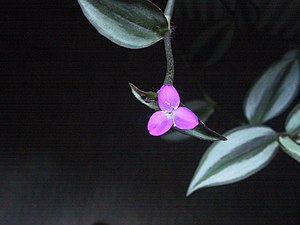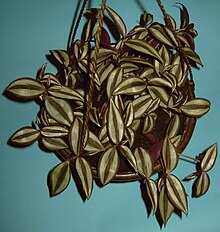Zebra ampelkraut
| Zebra ampelkraut | ||||||||||||
|---|---|---|---|---|---|---|---|---|---|---|---|---|

Zebra ampelkraut ( Tradescantia zebrina ) |
||||||||||||
| Systematics | ||||||||||||
|
||||||||||||
| Scientific name | ||||||||||||
| Tradescantia zebrina | ||||||||||||
| Bosses |
The zebra ampelkraut ( Tradescantia zebrina ), also called zebra herb, is a species of the three-masted flowers ( Tradescantia ), which is native to Guatemala and Mexico . It is used as an ornamental plant both outdoors and indoors.
description
The prostrate, weakly succulent , perennial , herbaceous plant often forms dense mats or colonies. This takes place primarily through the natural formation of depressions . At the nodes of the shoots there are roots, from which roots develop within a day under favorable conditions if there is permanent contact with water or a sufficiently moist substrate. The rungs are hairless or tomentose. The sessile, parallel- veined leaves are usually ovate, 4 to 10 cm long and 1.5 to 3 cm wide, pointed at the tip and rounded at the base. The upper side is hairless to slightly hairy, the underside hairless to averagely hairy, ciliate towards the base of the leaf. The leaves are bluish green and usually have two longitudinal stripes that are silvery on the surface and purple on the underside. The leaf sheaths are thin and translucent, 8 to 12 mm long and 5 to 8 mm wide, at the mouth they are long-ciliate, otherwise hairless or slightly hairy.
The flowers stand in groups, supported by two large, leaf-like, narrow, ciliate bracts . The hermaphroditic , radial symmetry flowers are threefold. The three fused sepals are 2 to 3 mm long. The three petals, which are only fused at the base, are ovate, truncated, pink to purple in color and 5 to 9 mm long. The six equally large stamens are hairy purple. Three carpels have become a top permanent ovary grown. They form capsule fruits that contain gray-brown seeds.
The number of chromosomes is 2n = 24.
Occurrence
This species is native to Guatemala and central and southern Mexico , but can also be found from Belize to El Salvador and Panama , as well as on the Caribbean islands . It grows in thickets in wet and rainforests , often on stones in shady and open places or on river banks at altitudes of 2000 meters or below, but mainly at lower altitudes.
Systematics
The first description as Tradescantia zebrina by Julius Friedrich Wilhelm Bosse was published in 1849. Synonyms are Zebrina pendula Schnizl. (1849), Cyanotis vittata Lindl. (1850), Commelina zebrina C.B. Clarke (1881, nom. Inval.), Tradescantia tricolor C.B. Clarke (1881), Zebrina pendula f. quadricolor Voss (1895), Zebrina pendula var. quadricolor (Voss) LHBailey (1902), Zebrina purpusii G.Brückn. (1927) and Tradescantia pendula (Schnizl.) DRHunt (1981).
One can differentiate between the following varieties:
- Tradescantia zebrina var. Flocculosa (G.Brückn.) DRHunt : It occurs from southeastern Mexico to Honduras.
- Tradescantia zebrina var. Mollipila D.R. Hunt : It occurs only in southeastern Mexico.
- Tradescantia zebrina var. Zebrina : It is native to Mexico to Colombia.
Use as an ornamental plant
The plant is not frost-resistant and is therefore kept in frost-prone areas all year round or as an indoor plant in the winter months. It is common to use it as a hanging or hanging plant. The propagation takes place mostly vegetatively by head cuttings that easily take root. Propagation by stem cuttings is also possible.
Use as a medicinal soft drink
In southern Mexico, mainly in the state of Tabasco , a tea is made from this plant, which is drunk cold, similar to iced tea with sugar and lime juice. The fruity-tasting tea is called "Agua de Matalí" in Spanish and has a reddish color. Allegedly this is a diuretic (drainage "tea"), which is supposed to help with digestive problems, among other things.
literature
- Paul C. Standley and Julian A. Steyermark: Flora of Guatemala , Field Museum of History Botanical Series, Volume 24, Part III, Chicago, USA, 1952. (There as Zebrina pendula )
- Fritz Encke: Plants for rooms and balconies , Eugen Ulmer, Stuttgart, 1964.
Individual evidence
- ^ Tropicos. [1]
- ^ Julius Friedrich Wilhelm Bosse: Complete manual of flower gardening . 2nd edition, Volume 4, 1849, pp. 655-656 ( online ).
- ↑ a b c d e Rafaël Govaerts (Ed.): Tradescantia - World Checklist of Selected Plant Families of the Royal Botanic Gardens, Kew. Last accessed on August 8, 2018.
